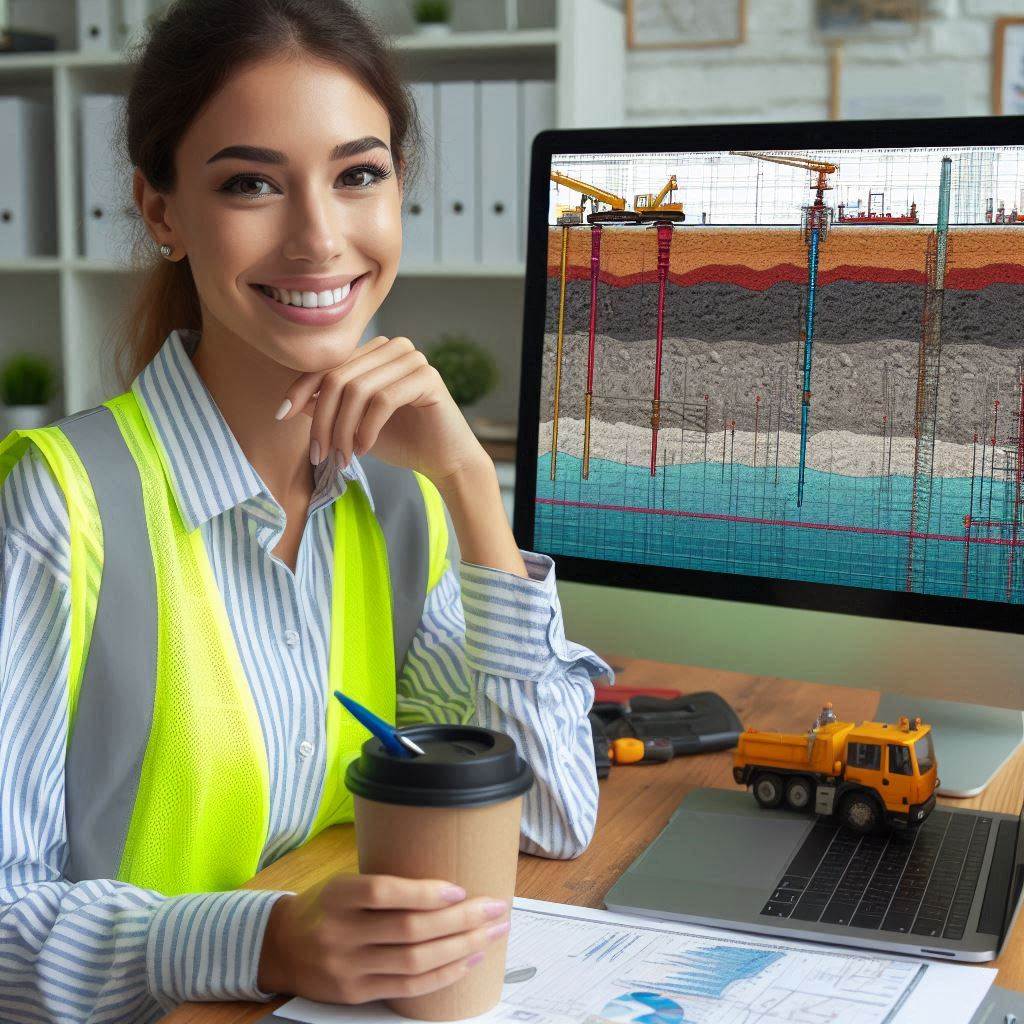Introduction
Geotechnical engineering is a specialized branch of civil engineering that focuses on analyzing and understanding the behavior of soil and rock to ensure the stability and safety of construction projects.
This field plays a crucial role in the design and construction of foundations, retaining walls, tunnels, and other structures that interact with the ground.
By evaluating ground conditions, geotechnical engineers can prevent structural failures and mitigate risks associated with soil and rock variability.
Staying updated on the latest innovations in geotechnical engineering is essential for professionals in this field.
The industry is constantly evolving, with new technologies and methodologies emerging to address complex challenges.
Innovations in geotechnical engineering can significantly enhance the accuracy and efficiency of subsurface evaluations, leading to more reliable and cost-effective engineering solutions.
Advancements such as advanced geophysical methods, including seismic tomography and ground-penetrating radar, allow engineers to obtain detailed subsurface information without extensive drilling.
These methods provide a clearer understanding of soil and rock properties, enabling better design decisions.
Additionally, innovations in soil stabilization techniques, such as the use of geosynthetics and chemical grouting, improve the performance and durability of foundations and other structures.
Use of drones in geotechnical engineering
Benefits of Using Drones for Site Surveys and Inspections
Drones have revolutionized site surveys and inspections in geotechnical engineering.
They provide numerous benefits, including increased efficiency and accuracy.
Drones can quickly cover large areas, significantly reducing the time needed for surveys.
This speed allows engineers to gather data more rapidly and begin analysis sooner.
Drones equipped with high-resolution cameras and sensors capture detailed images and data.
These tools offer a level of precision that surpasses traditional methods.
Engineers can use drones to access hard-to-reach or hazardous areas safely.
This capability enhances safety for personnel by minimizing the need for physical presence in dangerous locations.
Another major benefit is the ability to create 3D models and maps from drone data.
These models provide comprehensive visualizations of site conditions.
Engineers can analyze terrain features, soil composition, and other critical factors more effectively.
Drones also allow for continuous monitoring of sites.
Regular drone flights can track changes over time, providing valuable insights into site stability and potential issues.
This ongoing monitoring helps in making informed decisions and proactive interventions.
Drones also reduce costs associated with traditional survey methods.
The need for extensive ground crews and equipment is minimized, leading to lower labor and operational expenses.
Additionally, the use of drones can improve project timelines.
Faster data collection and analysis enable quicker decision-making and project progression.
The integration of drones into geotechnical engineering practices represents a significant advancement in the field.
Examples of Successful Drone Applications in the Field
Several successful drone applications highlight their impact on geotechnical engineering.
One notable example is the use of drones in landslide assessment.
Engineers use drones to survey landslide-prone areas and gather detailed topographical data.
This data helps in creating accurate hazard maps and planning mitigation strategies.
In one project, drones were used to monitor an active landslide area in California.
The detailed data collected allowed engineers to predict movement patterns and implement effective stabilization measures.
Drones have also been successfully used in mining operations.
They provide valuable data for pit wall stability and erosion monitoring.
In Australia, a mining company utilized drones to conduct regular inspections of mine sites.
The drones captured high-resolution images and 3D models, enabling engineers to detect and address potential stability issues promptly.
This application improved safety and operational efficiency in the mining process.
Another successful application is in infrastructure inspections.
Drones have been employed to inspect bridges, dams, and other critical structures.
In the United States, drones were used to inspect a series of aging bridges.
The drones captured detailed images of structural conditions, allowing engineers to identify areas requiring maintenance.
This approach reduced inspection time and minimized disruptions to traffic and daily operations.
Drones have also proven effective in environmental monitoring.
In a project in Canada, drones were used to monitor coastal erosion.
Engineers collected high-resolution aerial imagery to assess erosion rates and develop protective measures.
This application provided valuable data for environmental preservation efforts.
Read: Public Health and Environmental Engineering
Implementation of Artificial Intelligence in Geotechnical Analysis
How AI Can Streamline Data Analysis and Interpretation
Artificial Intelligence (AI) is revolutionizing geotechnical engineering by streamlining data analysis and interpretation.
AI algorithms can process large datasets quickly and accurately, reducing the time spent on manual analysis.
Machine learning models can identify patterns and trends in soil behavior, improving predictions and decision-making.
AI tools can automate repetitive tasks, allowing engineers to focus on more complex problem-solving.
These technologies enhance the accuracy of site assessments and the reliability of geotechnical designs.
By leveraging AI, geotechnical engineers can make more informed decisions, leading to safer and more efficient projects.
Case Studies Showcasing AI’s Impact on Geotechnical Projects
Several case studies highlight AI’s impact on geotechnical projects. One notable example is the use of AI in predicting landslides.
In a project in Japan, AI models analyzed historical data, weather patterns, and soil properties to predict landslide occurrences.
The AI system provided early warnings, enabling timely evacuations and mitigating damage.
This application of AI significantly improved the safety and preparedness of the region.
Another case study involves AI in tunneling projects.
In Switzerland, engineers used AI to analyze ground conditions and optimize tunnel boring machine (TBM) operations.
The AI system processed real-time data from sensors, predicting soil behavior and adjusting TBM parameters accordingly.
This approach minimized downtime and reduced the risk of machine damage, leading to cost savings and timely project completion.
AI also plays a crucial role in soil stability analysis.
In the United States, an AI-driven system was implemented to monitor soil movements in real time for a major highway project.
The system used sensor data to detect shifts and provided instant alerts to engineers.
This proactive monitoring helped prevent potential failures and ensured the safety of the construction site.
Furthermore, AI has been applied in foundation design optimization.
In a project in the United Kingdom, AI algorithms analyzed soil test results and construction parameters to design optimal foundation solutions.
The AI-generated designs reduced material usage and construction time while maintaining structural integrity.
This innovative approach demonstrated AI’s potential to enhance sustainability and efficiency in geotechnical engineering.
Read: Environmental Engineering Software and Tools
Advancements in Soil Stabilization Techniques
Soil stabilization is a crucial aspect of geotechnical engineering, as it involves enhancing the properties of soil to make it more suitable for construction.
In recent years, there have been significant advancements in soil stabilization techniques that have revolutionized the field.
These advancements have led to the introduction of new materials and methods for improving soil strength, resulting in more efficient and sustainable construction practices.
Introduction of New Materials
One of the major advancements in soil stabilization is the introduction of new materials that are used to enhance the strength and stability of soil.
These materials include various types of polymers, fibers, and chemical additives that can improve the engineering properties of soil.
For example, the use of geogrids and geotextiles has become increasingly popular in soil stabilization projects.
These materials are placed within the soil to provide reinforcement and prevent erosion, resulting in a more durable and stable foundation.
Another innovative material that is being used in soil stabilization is cementitious binders, which are mixed with soil to create a strong and durable base for construction.
These binders can improve the compressive strength of soil and reduce its susceptibility to erosion.
Methods for Improving Soil Strength
In addition to new materials, there have been advancements in the methods used for improving soil strength in geotechnical engineering.
One of the most common methods is soil compaction, which involves increasing the density of soil particles to enhance its load-bearing capacity.
Another method that has gained popularity is soil reinforcement, which involves adding materials such as geogrids, geotextiles, and steel bars to strengthen the soil and prevent deformation.
This method is particularly useful in areas with weak or unstable soil conditions.
Furthermore, soil mixing is another technique that has been developed to improve soil strength.
This method involves mixing soil with cement, lime, or other binding agents to create a stable and homogeneous foundation for construction projects.
Real-World Examples of Successful Projects
There are numerous examples of successful soil stabilization projects that showcase the effectiveness of these new materials and methods.
One notable project is the stabilization of soft clay soils in Singapore using a combination of geosynthetics and soil reinforcement techniques.
Another example is the construction of embankments and retaining walls in India using cementitious binders and soil compaction methods.
These projects have successfully improved the stability and strength of soil, allowing for the safe and efficient construction of infrastructure.
Overall, the latest innovations in geotechnical engineering have transformed the way soil stabilization is carried out, leading to more resilient and sustainable construction practices.
With the introduction of new materials and methods, engineers are now able to address challenging soil conditions and ensure the long-term stability of construction projects.
Transform Your Career Today
Unlock a personalized career strategy that drives real results. Get tailored advice and a roadmap designed just for you.
Start NowRead: Environmental Engineering and Corporate Social Responsibility

Integration of Building Information Modeling (BIM) in geotechnical design
Building Information Modeling (BIM) is a revolutionary technology that has been increasingly integrated into geotechnical engineering design processes.
BIM allows for the creation of detailed 3D models that not only capture the physical aspects of a project but also include vital information related to its construction, operation, and maintenance.
Geotechnical engineers are now using BIM to visualize and analyze subsurface conditions, ground behavior, and foundation designs.
By incorporating BIM into geotechnical design, engineers can improve project coordination, reduce errors, and enhance collaboration between various project stakeholders.
Benefits of using BIM for 3D visualization and collaboration
- Improved visualization: BIM enables geotechnical engineers to create accurate 3D models of subsurface conditions, allowing for better visualization of the project.
- Enhanced collaboration: BIM facilitates better communication and collaboration among project team members, leading to more efficient decision-making.
- Reduced errors and conflicts: By integrating geotechnical data into BIM models, potential clashes and errors can be identified and resolved early in the design process.
- Streamlined workflows: BIM helps streamline geotechnical design workflows, leading to improved project timelines and cost efficiency.
Case studies demonstrating the effectiveness of BIM in geotechnical projects
Several case studies have highlighted the benefits of using BIM in geotechnical projects.
One such example is the construction of a high-rise building in an urban area with challenging soil conditions.
By utilizing BIM, geotechnical engineers were able to analyze the subsurface conditions accurately, optimize foundation designs, and coordinate with other project disciplines seamlessly.
This resulted in cost savings, reduced construction delays, and improved project outcomes.
In another case study, a transportation infrastructure project utilized BIM to visualize underground utilities, assess potential risks, and optimize foundation designs.
The integration of geotechnical data into the BIM model allowed for better decision-making and improved project coordination.
Overall, the integration of BIM in geotechnical engineering design has proven to be a game-changer, offering significant benefits in visualization, collaboration, error reduction, and project efficiency.
As technology continues to evolve, geotechnical engineers can expect further advancements in BIM applications for enhanced project outcomes.
Read: The Future of Environmental Engineering Jobs
Sustainable practices in geotechnical engineering
Importance of Eco-Friendly Solutions in Construction Projects
Eco-friendly solutions are increasingly important in construction projects today.
The construction industry significantly impacts the environment, contributing to resource depletion, pollution, and habitat destruction.
Adopting sustainable practices in geotechnical engineering helps mitigate these effects.
Engineers play a critical role in developing and implementing green technologies and methods.
By focusing on eco-friendly solutions, geotechnical engineers can reduce the carbon footprint of construction projects.
Sustainable practices also help in complying with environmental regulations and meeting societal expectations for responsible development.
Eco-friendly solutions enhance the long-term viability and resilience of infrastructure projects.
Examples of Innovative Sustainable Geotechnical Practices
Innovative sustainable practices have emerged in geotechnical engineering.
Engineers now use recycled materials, such as aggregates and plastics, in construction.
This approach reduces waste and the demand for virgin materials.
They also develop bio-based solutions, like bio-cementation, using microorganisms to strengthen soil.
These eco-friendly techniques offer alternatives to traditional cement-based methods and minimize environmental impact.
Geosynthetics, including geotextiles and geomembranes, enhance soil performance and reduce the need for extensive earthworks.
They improve drainage, erosion control, and soil reinforcement, contributing to sustainable construction.
Engineers integrate green roofs and walls into building structures to promote sustainability.
These systems manage stormwater, reduce heat islands, and improve air quality.
Ground improvement methods now use eco-friendly binders and additives.
Techniques like soil mixing and jet grouting improve soil properties without harmful environmental effects.
Renewable energy sources, such as geothermal energy, are becoming more prevalent in geotechnical applications.
Geothermal systems provide sustainable heating and cooling solutions for buildings, reducing reliance on fossil fuels.
Permeable pavements allow water to infiltrate through the surface, reducing runoff and promoting groundwater recharge.
They manage stormwater effectively and mitigate urban flooding.
Engineers explore modular construction techniques, prefabricating building components off-site.
This approach reduces waste, minimizes on-site disruption, and speeds up construction times.
In summary, eco-friendly solutions are essential for sustainable construction projects.
Geotechnical engineers play a pivotal role in adopting and advancing these practices.
Using recycled materials, bio-based solutions, geosynthetics, and renewable energy sources, engineers transform the industry.
These advancements mitigate environmental impacts, comply with regulations, and meet societal expectations.
By focusing on eco-friendly solutions, geotechnical engineers create resilient, sustainable infrastructure benefiting both people and the planet.
Gain More Insights: IT Support Specialist: Degree vs. Certifications
Emerging trends in geotechnical instrumentation
In recent years, geotechnical engineering has seen significant advancements in instrumentation, providing engineers with better tools to monitor and analyze soil behavior.
This has led to more efficient and safer construction practices. Let’s delve into the emerging trends in geotechnical instrumentation:
Introduction of New Monitoring Technologies
Traditionally, geotechnical engineering relied on manual methods and basic sensors to monitor soil conditions.
However, with the introduction of new technologies such as wireless sensors, drones, and satellite imagery, engineers can now collect real-time data on soil behavior with greater accuracy and efficiency.
Wireless sensors, for example, can be embedded in the ground to monitor factors like temperature, moisture content, and pressure.
These sensors transmit data wirelessly to a central monitoring system, eliminating the need for manual data collection and reducing the risk of human error.
Drones equipped with high-resolution cameras and LiDAR technology are used to survey large areas of land quickly and accurately.
This allows engineers to identify potential geotechnical hazards and plan construction projects more effectively.
Satellite imagery is another valuable tool in geotechnical instrumentation.
By analyzing satellite data, engineers can track changes in ground movement, monitor slope stability, and assess the impact of environmental factors on soil behavior.
Case Studies Demonstrating Impact
Several case studies have showcased the positive impact of advanced instrumentation on project outcomes.
For example, a study conducted on a highway construction project revealed that the use of wireless sensors significantly improved the monitoring of embankment stability.
By continuously collecting data on factors like settlement and pore water pressure, engineers were able to detect potential issues early on and take corrective measures to prevent costly delays and safety hazards.
This proactive approach ultimately led to the successful completion of the project within the allotted timeframe and budget.
In another case study involving the construction of a high-rise building, the use of drones for site surveying saved both time and money.
By quickly generating accurate topographic maps and 3D models of the site, engineers were able to identify the best locations for deep foundation support, reducing the risk of settlement and ensuring structural integrity.
Overall, these case studies highlight the importance of embracing new monitoring technologies in geotechnical engineering.
By leveraging advanced instrumentation, engineers can enhance project efficiency, minimize risks, and ultimately deliver better outcomes for clients and communities.
Transform Your Career Today
Unlock a personalized career strategy that drives real results. Get tailored advice and a roadmap designed just for you.
Start NowConclusion
Geotechnical engineering is rapidly evolving with new technologies revolutionizing the industry.
One such innovation is the use of unmanned aerial vehicles (UAVs) for site inspections.
The ability of UAVs to capture high-resolution images of difficult-to-reach areas has greatly enhanced data collection and analysis in geotechnical engineering projects.
Advancements in artificial intelligence and machine learning have also played a significant role in geotechnical engineering.
These technologies enable engineers to process large amounts of data more efficiently.
Another cutting-edge development in geotechnical engineering is the use of 3D printing for constructing intricate and customized structural elements.
This technology offers improved precision and cost-effectiveness.
Furthermore, underground mapping technologies such as ground-penetrating radar (GPR) have revolutionized the way engineers survey and analyze subsurface conditions, leading to safer and more accurate project designs.
Geotechnical instrumentation and monitoring systems have also seen significant advancements, providing real-time data on factors like soil movement, groundwater levels, and structural stability.
Lastly, staying updated on the latest innovations in geotechnical engineering is crucial for professionals in the field.
Embracing new technologies and practices can enhance project outcomes and improve overall efficiency.
It is essential for geotechnical engineers to adapt to these advancements to remain competitive in the industry and deliver optimal solutions for their clients.
By embracing innovation, professionals can stay ahead of the curve and drive progress in the field.




